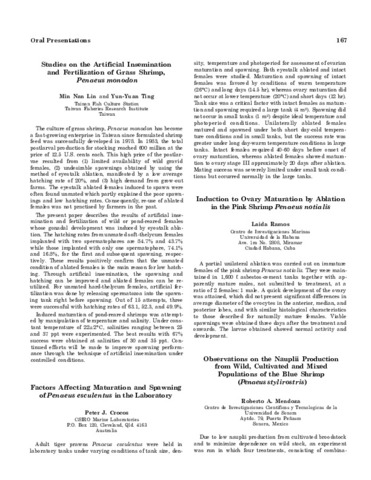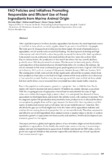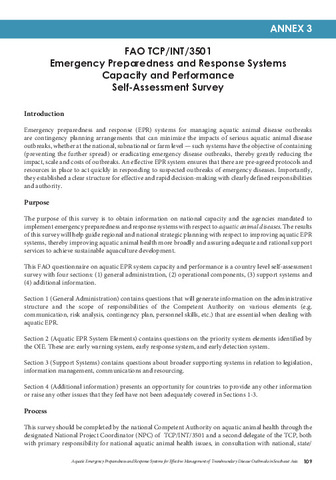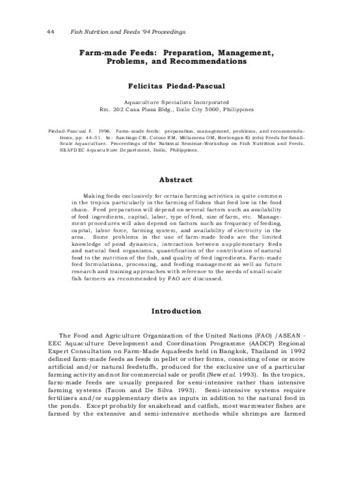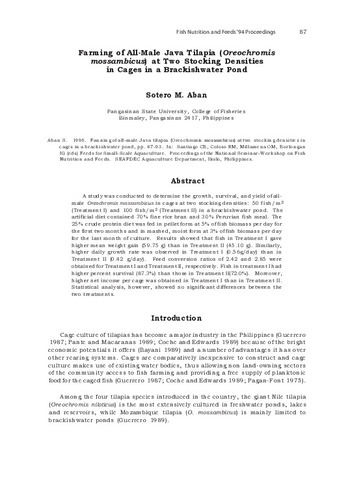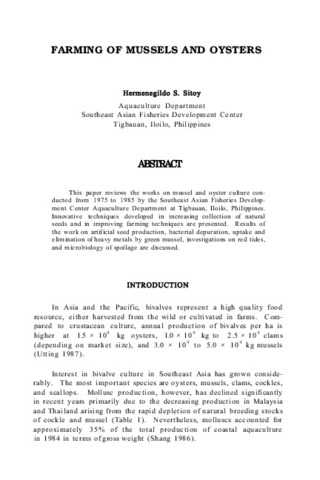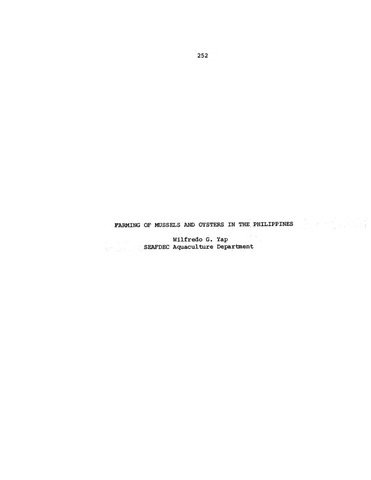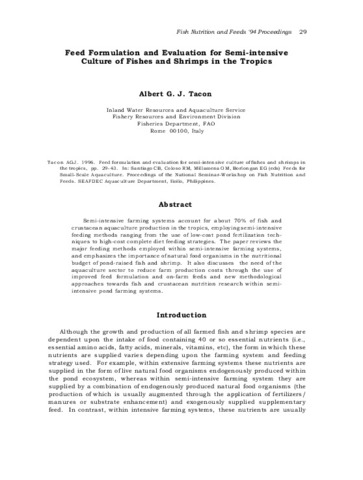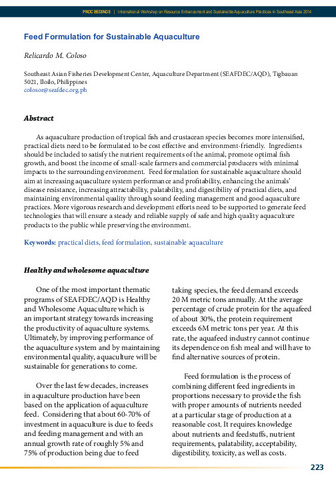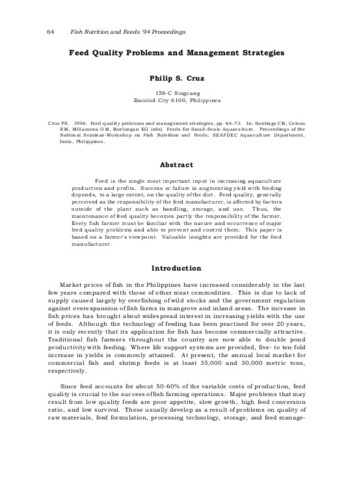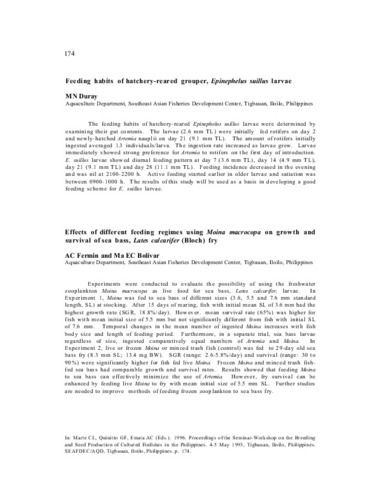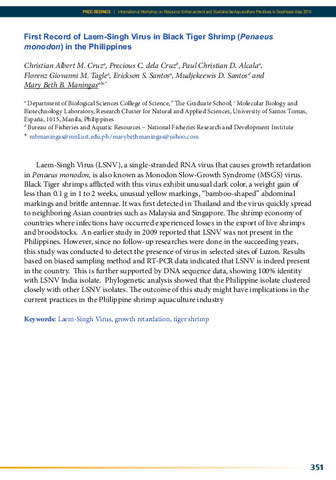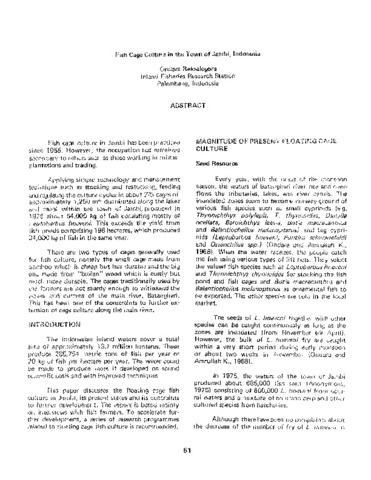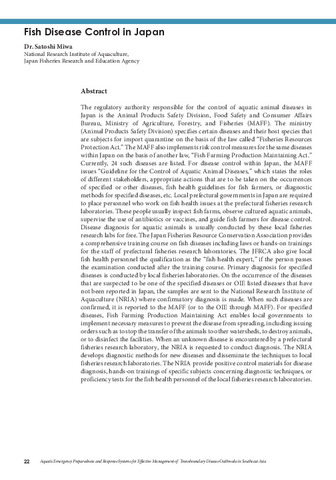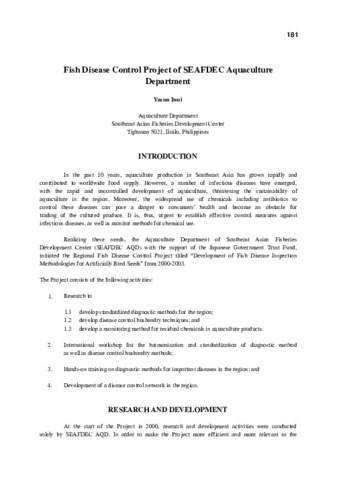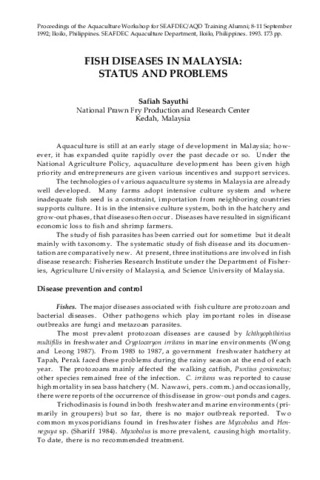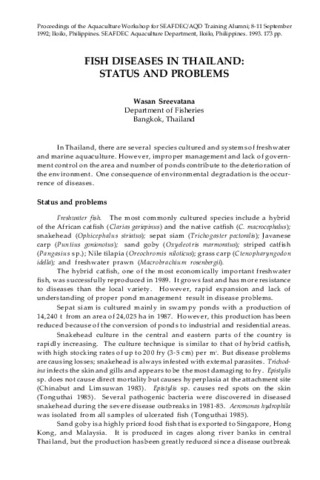Browsing Conference Proceedings by Title
Now showing items 242-261 of 767
-
Factors affecting maturation and spawning of Penaeus esculentus in the laboratory
(Aquaculture Department, Southeast Asian Fisheries Development Center, 1985)Adult tiger prawns Penaeus esculentus were held in laboratory tanks under varying conditions of tank size, density, temperature and photoperiod for assessment of ovarian maturation and spawning. Both eyestalk ablated and ... -
Factors affecting mortality of shrimp, Penaeus monodon, experimentally infected with Vibrio parahaemolyticus causing acute hepatopancreatic necrosis disease (VPAHPND)
(Aquaculture Department, Southeast Asian Fisheries Development Center, 2021-12)One of the most recent diseases affecting the shrimp industry is the early mortality syndrome (EMS). EMS, characterized by observed mortality in shrimp within the first 35 days of culture, is due to several diseases, one ... -
FAO policies and initiatives promoting responsible and efficient use of feed ingredients from marine animal origin
(Aquaculture Department, Southeast Asian Fisheries Development Center, 2015)After rapid development for three decades, aquaculture has become the most important source of food fish in Asia, which currently supplies about 55 per cent of food fish for the people. The rapid growth of aquaculture ... -
FAO TCP/INT/3501: Emergency preparedness and response systems capacity and performance self-assessment survey
(Aquaculture Department, Southeast Asian Fisheries Development Center, 2019)The purpose of this survey is to obtain information on national capacity and the agencies mandated to implement emergency preparedness and response systems with respect to aquatic animal diseases. The results of this survey ... -
Farm-made feeds: preparation, management, problems, and recommendations
(Aquaculture Department, Southeast Asian Fisheries Development Center, 1996)Making feeds exclusively for certain farming activities is quite common in the tropics particularly in the farming of fishes that feed low in the food chain. Feed preparation will depend on several factors such as availability ... -
Farming of all-male java tilapia (Oreochromis mossambicus) at two stocking densities in cages in a brackishwater pond
(Aquaculture Department, Southeast Asian Fisheries Development Center, 1996)A study was conducted to determine the growth, survival, and yield of allmale Oreochromis mossambicus in cages at two stocking densities: 50 fish/m2 (Treatment I) and 100 fish/m2 (Treatment II) in a brackishwater pond. The ... -
Farming of mussels and oysters
(Aquaculture Department, Southeast Asian Fisheries Development Center, 1988)This paper reviews the works on mussel and oyster culture conducted from 1975 to 1985 by the Southeast Asian Fisheries Development Center Aquaculture Department at Tigbauan, Iloilo, Philippines. Innovative techniques ... -
Farming of mussels and oysters in the Philippines
(Aquaculture Department, Southeast Asian Fisheries Development Center, 1979) -
Feed development
(Aquaculture Department, Southeast Asian Fisheries Development Center, 1984)The paper gave an overview of the status of prawn feed development in the Philippines. Nutrient requirements, diet development, food and feeding habits, diet formulations for prawn (P. monodon) were discussed. Diets for ... -
Feed formulation and evaluation for semi-intensive culture of fishes and shrimps in the tropics
(Aquaculture Department, Southeast Asian Fisheries Development Center, 1996)Semi-intensive farming systems account for about 70% of fish and crustacean aquaculture production in the tropics, employing semi-intensive feeding methods ranging from the use of low-cost pond fertilization techniques to ... -
Feed formulation for sustainable aquaculture
(Aquaculture Department, Southeast Asian Fisheries Development Center, 2015)As aquaculture production of tropical fish and crustacean species becomes more intensified, practical diets need to be formulated to be cost effective and environment-friendly. Ingredients should be included to satisfy the ... -
Feed quality problems and management strategies
(Aquaculture Department, Southeast Asian Fisheries Development Center, 1996)Feed is the single most important input in increasing aquaculture production and profits. Success or failure in augmenting yield with feeding depends, to a large extent, on the quality of the diet. Feed quality, generally ... -
Feeding habits of hatchery-reared grouper, Epinephelus suillus larvae
(Aquaculture Department, Southeast Asian Fisheries Development Center, 1996)The feeding habits of hatchery-reared Epinephelus suillus larvae were determined by examining their gut contents. The larvae (2.6 mm TL) were initially fed rotifers on day 2 and newly-hatched Artemia nauplii on day 21 (9.1 ... -
First record of Laem-Singh virus in black tiger shrimp (Penaeus monodon) in the Philippines
(Aquaculture Department, Southeast Asian Fisheries Development Center, 2015)Laem-Singh Virus (LSNV), a single-stranded RNA virus that causes growth retardation in Penaeus monodon, is also known as Monodon Slow-Growth Syndrome (MSGS) virus. Black Tiger shrimps afflicted with this virus exhibit ... -
Fish cage culture in the town of Jambi, Indonesia
(Aquaculture Department, Southeast Asian Fisheries Development Center; International Development Research Centre, 1979)This paper discusses the floating cage fish culture in Jambi, its present status and its constraints to further development. The report is based mainly on interviews with fish farmers. To accelerate further development, a ... -
Fish culture in cages in Lake Danao, Cebu
(Aquaculture Department, Southeast Asian Fisheries Development Center; Philippine Council for Aquatic and Marine Research and Development (PCAMRD), Department of Science and Technology; Bureau of Fisheries and Aquatic Resources, 2001)Lake Danao is a picturesque inland body of water having an area of 685 ha located in the municipality of San Francisco in Pacijan Island, Camotes, Cebu. At the middle of the lake is a circular islet with an area of one ... -
Fish disease control in Japan
(Aquaculture Department, Southeast Asian Fisheries Development Center, 2019)The regulatory authority responsible for the control of aquatic animal diseases in Japan is the Animal Products Safety Division, Food Safety and Consumer Affairs Bureau, Ministry of Agriculture, Forestry, and Fisheries ... -
Fish disease control project of SEAFDEC Aquaculture Department
(Aquaculture Department, Southeast Asian Fisheries Development Center, 2002) -
Fish diseases in Malaysia: Status and problems
(Aquaculture Department, Southeast Asian Fisheries Development Center, 1993)Aquaculture is still at an early stage of development in Malaysia; however, it has expanded quite rapidly over the past decade or so. Under the National Agriculture Policy, aquaculture development has been given high ... -
Fish diseases in Thailand: Status and problems
(Aquaculture Department, Southeast Asian Fisheries Development Center, 1993)In Thailand, there are several species cultured and systems of freshwater and marine aquaculture. However, improper management and lack of government control on the area and number of ponds contribute to the deterioration ...

